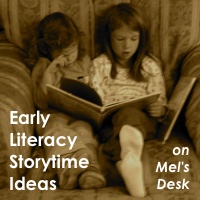Children who go to school knowing the parts of a book and how to turn pages can jump right in and start working on learning how to decode and sound words out. Children who haven’t spent time with books must first use valuable classroom time to lay the groundwork of learning what print is and how books work.
You can play “Simon Says” with books in your storytime. Gather enough board books for every child to have one–they don’t have to be the same title. Hand them out when you’re ready to play. Give them some instructions for playing, for example, “In Simon Says, I tell you to do something, and you do it. But the trick is, you ONLY do what I say IF I say Simon Says first. Let’s try it! Simon Says…put your book on your head! That’s right! I said Simon Says so you do what I say. Let’s try again. Put your book on the floor. Oops! I didn’t say Simon Says so you don’t do what I say. OK, here we go!” Don’t worry about penalties for getting it wrong! Just say, “Oh no!” and go on to the next command.
With younger kids, Simon Says can be pretty tricky. Skip it if you think it will be more frustrating than fun. Instead, play “Follow the Leader,” and ask them to do what you do. Call out what you’re doing as you do it. Use some ideas just for fun and some that prompt the kids to manipulate the books.
Updated 6/24 afternoon: So the SAME MORNING I have this post scheduled, the amazing Cate sends a link to this article out on Twitter: Simon Says: Why Is This Game So Hard for Young Kids? Simon Says really IS tricky, even for big kids, so please trust your instincts for what will work with your group! My main goal here is to find a fun way to get books into kids’ hands during storytime, and not just in our own. Another tactic is to let babies play with books. What other ways could we do this?
Here are some sample commands:
Put the book on your head
Sit on the book
Give the book to your grownup
Hold the book in both hands
Open the cover
Show me the back cover
Hold the book right-side-up
Turn to the very last page
With older children, you could do things like:
Open the book and point to a word
Open the book and point to an illustration
Point to the title
After you’ve played a few rounds, say something like this to the adults: “Grownups, every time you read to your child or let them look through books by themselves, they are learning all about how books work. This helps them become a good reader because if they already know how to use a book before they go to school, they can skip all that and focus on learning how to read. Reading with your child helps them get ready to read.”



.jpg)
